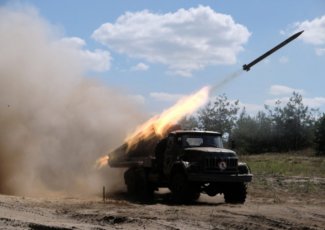Russian missile attacks intensify. Day 572 of the war

Russian missiles attacked industrial facilities in Kharkiv for three consecutive days starting on 16 September. Their main target was the Kharkovskiy Bronetankovy Zavod (KhBTZ), which repairs heavy armaments and military equipment. The production halls and warehouses were hit by five Iskander-K cruise missiles (16 September), four missiles from S-300 systems (17 September) and three ballistic missiles of an unconfirmed type (18 September). The defenders failed to shoot down any of the missiles fired by the invaders. Ukrainian sources reported dead and wounded, and it was officially confirmed that five people were wounded in the 16 September attack, and six the next day.
On 17 September, the invaders used missiles and drones to launch attacks on the Odesa (grain stores were destroyed) and Khmelnytsky oblasts. The Ukrainian Air Force Command stated that six of the 10 Kh-101/Kh-555/Kh-55 cruise missiles and all six of the Shahed-136/131 kamikaze drones used were shot down. The attacks on the Odesa (the port of Reni in the Danube delta) and Khmelnitsky oblasts (the local administration reported two explosions at an industrial site) were repeated on 18 September, on which day Russian kamikaze drones also hit Ochakiv in Mykolaiv oblast. According to the Air Force Command, 18 of the 24 Shahed-136/131 drones used and all 17 of the Kh-101/Kh-555/Kh-55 missiles were destroyed. According to the General Staff of the Ukrainian army, the enemy steadily increased the number of missiles used in the attacks. On 16 September they used a total of eight, on 17 September 15, and on 18 September 22 ballistic & cruise missiles.
On 19 September, Russian kamikaze drones struck warehouses in Lviv. According to the local authorities, three warehouses carrying humanitarian aid were destroyed, with losses amounting to ‘hundreds of millions’ of hryvnias. Among other things, the production hall of the Lviv branch of the Polish-based company Fakro (the world’s second largest manufacturer of roof windows), which had lent storage space to Caritas Lviv, was burnt down; the losses are estimated at around €6.5 million. Khmelnytskyi oblast was targeted once more, this time with Shahed-136/131 drones; meanwhile an Iskander-K cruise missile hit Kryvyi Rih, and a ballistic missile of an unconfirmed type hit Odradne in Kharkiv oblast. The Air Force Command reported that 27 of the 30 kamikaze drones used by the invaders had been shot down.
On 17 September Ukrainian forces carried out further drone attacks on occupied Crimea (at Cape Fiolent near Sevastopol) as well as the Moscow, Kaluga, Oryol, Tver and Voronezh oblasts on Russian territory. The strikes are unlikely to have caused any serious losses, with the Russian side reporting that all the drones had been destroyed. The Ukrainians also stepped up their rocket attacks on the enemy’s military hinterland: Tokmak was targeted on 16 and 17 September, Donetsk on 18 September (the occupiers’ administration building was hit), and Melitopol on 19 September. On 15 September, the Ukrainian media reported an attack by the Security Service of Ukraine’s experimental Morsky Maluk drone on the Russian small missile corvette Samum near Sevastopol (the ship was reportedly damaged), although this has not been independently confirmed.
On 17 September General Oleksandr Syrsky, the commander of the Ukrainian Land Forces, officially announced the liberation of the village of Klishchiivka, which lies south-west of Bakhmut. Fighting in the area (including for Andriivka, which the Ukrainians retook the previous week) is expected to continue; the Ukrainian side has probably gone on the defensive, and is now repelling enemy counterattacks. Neither side’s attacks have resulted in any change; the Russians, who have so far been on the defensive, may be expected to increase their activity south of Orikhiv. According to the Ukrainian General Staff, Marinka is the arena of particularly heavy clashes, where the defenders are repelling an average of 10 Russian assaults per day. On 18 September, Ukrainian deputy defence minister Hanna Malar summarised the Ukrainians’ progress over the past week; they have recaptured a further 2 km2 of territory in the area of Bakhmut, making a total of 51 km2 there since the start of the Ukrainian offensive; and in the south, mainly around the village of Robotyne, they have retaken 5.2 km2 (making a total of over 260 km² in that area).
On 18 September, in an interview with the Economist, the head of Ukrainian military intelligence (HUR), General Kyrylo Budanov, stated that the Russian Federation has “absolutely no strategic reserve”. Their newly-formed 25th Combined Arms Army, which is being “prematurely prepared” to head in the direction of Lyman and Kupyansk, is expected to use 80% of the reserve’s personnel and 55% of the equipment. Budanov acknowledged that the Ukrainian Armed Forces could break Russia’s land connection with Crimea by winter. Later that day, the chairman of the US Joint Chiefs of Staff of the Armed Forces, General Mark Milley, estimated the number of Russian troops in the occupied part of Ukraine at 200,000 (on 10 September HUR reported a figure of 420,000). According to Milley, the current Ukrainian offensive “has limited operational and tactical objectives”, and “even if [those objectives] were fully achieved”, the Ukrainian Armed Forces “will not knock out all the Russians” and will not regain control of all the lost territory.
On 15 September, Belgian defence minister Ludivine Dedonder said that in 2024 two Belgian F-16 fighter jets on which Ukrainian pilots will be trained will be sent to Denmark, as will a 50-strong team of instructors and aircraft maintenance personnel. In addition, six Ukrainian instructors and four air mission planning specialists will receive training in Belgium. On the same day, John Cockerill Defence (JCD) stated that it had handed over the first 10 refurbished M113 tracked transporters to the Belgian army at the end of August for deployment to Ukraine. By the end of November, JCD is to refurbish a total of 40 M113s for the Ukrainian army. On 18 September, German defence minister Boris Pistorius announced a new support package worth €400 million for Kyiv. This will also include military aid including ammunition and demining equipment, although the most essential part of the package is civilian necessities, including generators and warm clothes, which will be needed ahead of the upcoming winter. 19 September saw the start of the 15th meeting of the Ramstein-format contact group of countries supporting Ukraine militarily.
On 15 September, a Pentagon representative reported that the US had handed over industrial 3D printers to Kyiv to produce spare parts for weapons and military equipment. These were due to arrive in Ukraine in August, and the training of their operators was completed last week. According to Washington, the Ukrainians had been manufacturing spare parts for Western-supplied equipment on their own since the start of the war without the necessary permits or technical documentation. With eventual help from Kyiv’s allies, this issue has now been resolved.
On 16 September, estimates from the Ukrainian General Staff on the costs incurred by Russia during its invasion of Ukraine were published; around $167.3 billion (about $300 million per day) has been spent over the last year and a half. The largest expenditure was in support of the war effort ($51.3bn), salaries ($35.1bn) and compensation for the families of the fallen ($25.6bn) and wounded ($21bn). As the rouble’s exchange rate falls, the value of individual compensation is falling (from $110,000 last year to $65,000 today). The value of the missiles used against Ukraine is estimated at more than $21.1bn.
On 16 September Oleksiy Danilov, the Secretary of the National Security and Defence Council of Ukraine, published an article in which he considered the prospects for the war. He stressed that there was only one way to end it: the liberation of Ukrainian lands by military means; this will involve the rapid supply of sufficient quantities of modern weaponry. He considered the practice of rationing military aid out of fear that its acceleration would provoke Russia to further escalation to be wrong. He also declared that refusing or delaying the transfer of modern weaponry was directly encouraging the Kremlin to continue the war.
On 18 September, six deputy ministers and the secretary of state at the Ministry of Defence were dismissed. Only Lieutenant General Oleksandr Pavluk, who took up the post in mid-February this year, retained his position as first deputy minister. He is an experienced military man, who among other positions was commander of the Combined Forces of the Ukrainian army. The resignations are the result of the newly appointed defence minister Rustem Umierov’s plans to reshape the leadership of the ministry.
On 18 September a drone armed with an explosive device was found in the Bulgarian town of Tiulenovo on the Black Sea coast. Bulgarian defence minister Todor Tagarev did not give any information on the drone’s country of origin, stating only that its downing is related to the war that Russia is waging. In doing so, he warned that similar incidents must be expected.
Also on 18 September, the Ukrainian Customs Service announced that $2.5 billion worth of goods designated as special trade (for military and dual-use purposes) had been imported in the first half of this year.
On the same day the Ukrainian Centre for National Resistance, citing the ‘Belarusian underground’, stated that some 1000 Wagner Group mercenaries were still in Belarus, and that 200 of them were instructors employed by the local armed forces and the interior ministry.
Commentary
- The attacks on the KhBTZ and the neighbouring facilities which other establishments were using as storage space for repaired armaments and military equipment confirm that the Ukrainians have managed to organise well-functioning service structures relatively close to the front line. Since the spring, Kharkiv has been attacked more sporadically, allowing the KhBTZ to restore at least partial functionality and develop its repair work on a wider scale. This facility, together with the Malyshev tank plants, were among the main targets of Russian strikes on the city in the first period of the war (production at the Malyshev plant has not resumed). It remains unclear how effective the attacks on Kharkiv on 16–18 September were; however, it must be assumed that they will at least partially reduce the capacity of the Khortytsia Operational-Strategic Group, which is responsible for defence in the east. This will be of particular importance if the invaders resume their offensive operations on the border of Kharkiv and Luhansk oblasts.
- The handover of industrial 3D printers to Kyiv confirms that the West is running out of spare parts for the older types of armaments and military equipment it has been supplying to Ukraine, and that Washington considers it uneconomic to resume their manufacture by classical methods (casting, forging, machining). The question is to what extent the Ukrainians will be able to use the equipment given to them. The 3D printers they have in their possession primarily enable the production of components from thermoplastic materials (it is mainly drone components which are constructed this way), while 3D printing from metallic powders (the main feature of the machines sent by the Americans) is up to ten times more expensive than milling. In all likelihood, the American machines will mainly be used to produce small, precise components that are difficult to obtain by machining.






